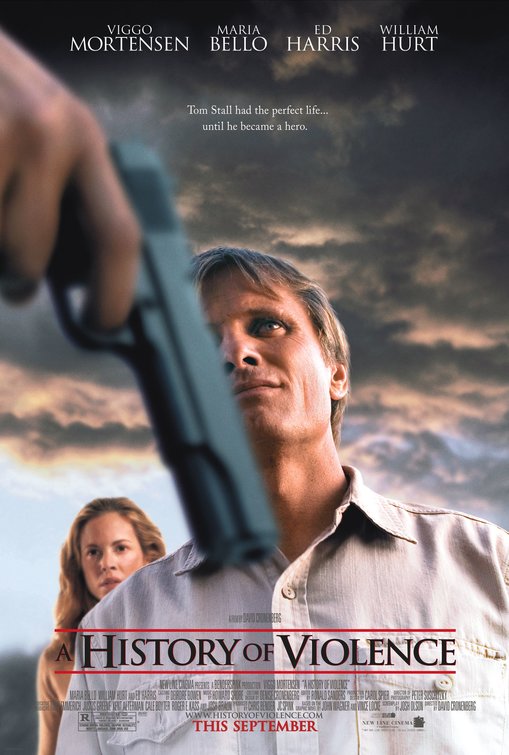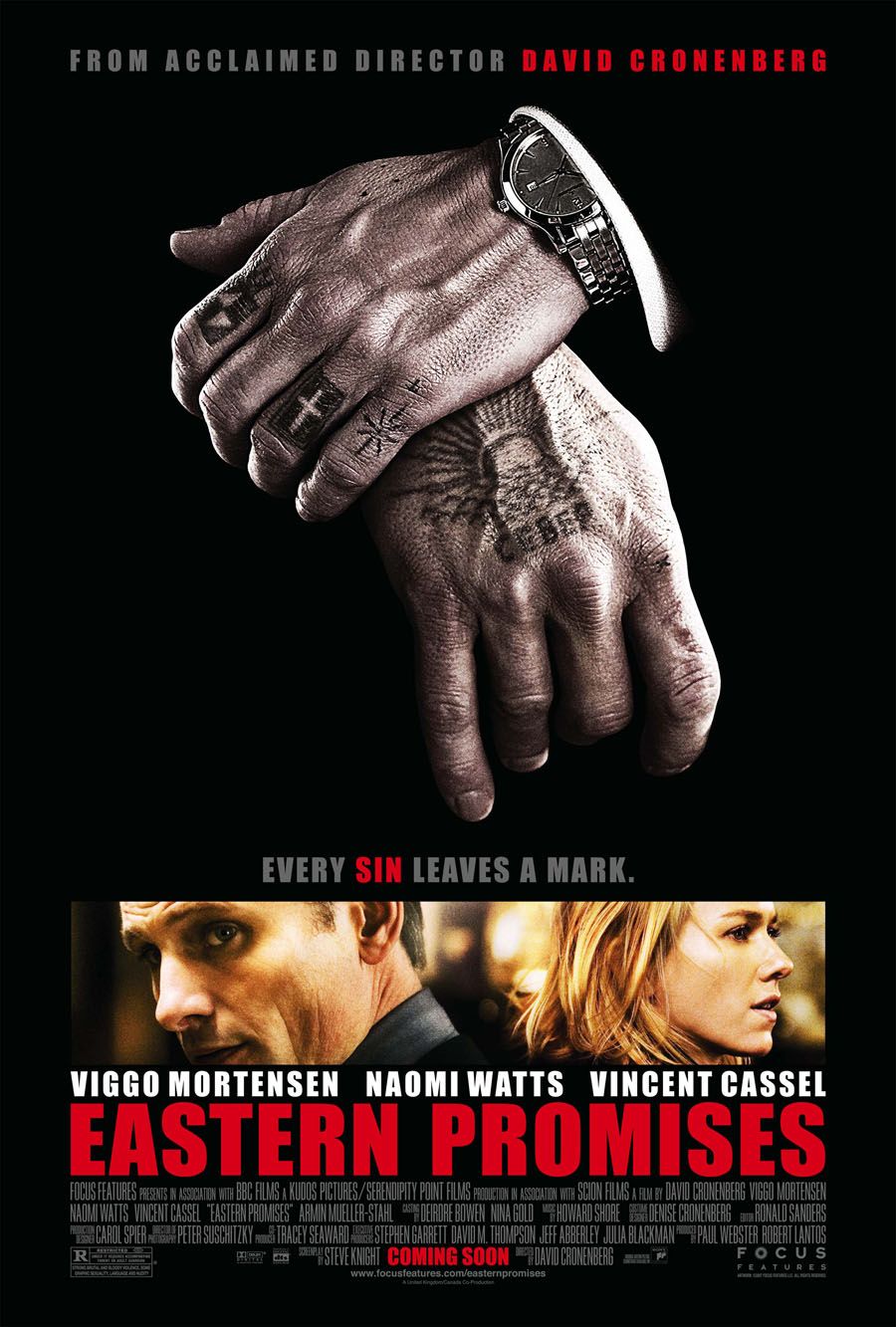For me the first fact of human existence is the human body. I’m not an atheist, but for me to turn away from any aspect of the human body to me is a philosophical betrayal. And there’s a lot of art and religion whose whole purpose is to turn away from the human body. I feel in my art that my mandate is to not do that. So whether it’s beautiful things—the sexuality part, or the violent part or the gooey part—it’s just body fluids. It’s when Elliott in Dead Ringer (sic) says, “Why are there no beauty contests for the insides of bodies?” It’s a thought that disturbs me. How can we be disgusted by our own bodies? That really doesn’t make any human sense. It makes some animal sense but it doesn’t make human sense so I’m always discussing that in my movies and in this movie in particular. I don’t ever feel that I’ve been exploitive in a crude, vulgar way, or just doing it to get attention. It’s always got a purpose which I can be very articulate about. In this movie, we’ve got an audience that’s definitely going to applaud these acts of violence and they do because it’s set up that these acts are justifiable and almost heroic at times. But I’m saying, “Okay, if you can applaud that, can you applaud this?” because this is the result of that gunshot in the head. It’s not nice. And even if the violence is justifiable, the consequences of the violence are exactly the same. The body does not know what was the morality of that act. So I’m asking the audience to see if they can contain the whole experience of this violent act instead of just the heroic/dramatic one. I’m saying “Here’s the really nasty effects on these nasty guys but still, the effects are very nasty.” And that’s the paradox and conundrum.” – David Cronenberg on A History of Violence
Introduction to Cronenberg’s work
David Cronenberg’s work is rich with recurring themes and motifs that delve into the complexities of the human condition, the body, and society. His unique narrative and visual style have made him a significant figure in the landscape of cinema, particularly in the realms of body horror and psychological thriller genres. Below are key themes and motifs that pervade Cronenberg’s oeuvre:
Transformation and Metamorphosis
One of Cronenberg’s most prevalent themes is transforming the human body and psyche. This is often depicted literally, with characters undergoing physical metamorphoses that serve as metaphors for psychological or emotional change. Films like The Fly and Videodrome exemplify this theme, exploring how these transformations challenge our understanding of identity and humanity.
Technology and the Human Body
Cronenberg frequently explores the blurring lines between technology and the human body, questioning the implications of their convergence. In eXistenZ and Videodrome, technology is not just a tool but becomes an integral part of the human experience, altering perceptions of reality and identity. This motif raises questions about the influence of technology on our lives and the potential loss of humanity.
Identity and Self
The question of identity is at the core of many Cronenberg films, where characters often struggle with their sense of self amidst external pressures or internal transformations. This is evident in Dead Ringers, where twin gynecologists experience a crisis of identity, and in The Fly, where the protagonist’s physical metamorphosis leads to an existential crisis.
Grotesque and Taboo
Cronenberg does not shy away from exploring themes that are considered taboo or grotesque. His films often confront uncomfortable truths about the human body, sexuality, and mortality, challenging viewers to reconsider their perceptions and prejudices. The grotesque becomes a lens through which the fragility and complexity of the human condition are examined.
Psychosocial Dynamics
Many of Cronenberg’s films delve into the psychological underpinnings of societal and interpersonal dynamics. A Dangerous Method explores the birth of psychoanalysis and the complex relationships between its founders, while Crash delves into the psychological interplay between trauma, technology, and desire. These films highlight Cronenberg’s interest in the mind and its influence on behavior and society.
Alien and Other
Cronenberg often explores the concept of the “other” — entities or ideas that are alien to the established norm. This can manifest through literal alienation, as in The Brood, where mutant children represent the physical embodiment of rage and alienation, or through the exploration of alternative lifestyles and desires, as in Crash. This theme challenges viewers to confront their fears and prejudices regarding what is considered “normal” or “acceptable.”
Through these themes and motifs, David Cronenberg invites his audience into a world where the boundaries of the body, the mind, and society are not just crossed but redefined. His films offer a deep, often unsettling exploration of what it means to be human in a rapidly changing world, making him one of the most thought-provoking directors in modern cinema.
Transition to Mainstream Cinema: 2005-2014
From 2005-2014, Cronenberg experimented with seemingly more mainstream affairs. A History of Violence, Eastern Promises, A Dangerous Method, and Maps to the Stars were works adapted from other people’s scripts. Cronenberg films are usually characterized by being written and directed by Cronenberg. The only time before this that Cronenberg directed someone else’s script was The Dead Zone (1983). An adaptation of Stephen King’s novel written by Jeffrey Boam, his first foray into more mainstream work.
A History of Violence (2005) and Eastern Promises (2007) stand as pivotal works within David Cronenberg’s illustrious career, embodying a shift towards more narrative-driven, character-centric storytelling, while still deeply engaging with the director’s longstanding thematic preoccupations. These films, though more grounded in realism compared to his earlier, more fantastical works, continue to explore Cronenberg’s fascination with the human body, identity, violence, and the undercurrents of society’s darker aspects. Here’s how they relate to and complement the broader themes and motifs found in Cronenberg’s body of work:
Psychological Depth
In both A History of Violence and Eastern Promises, Cronenberg continues to explore the motif of violence as a transformative force, a theme prevalent throughout his work. However, unlike his earlier films, where violence often leads to physical mutation or horror (The Fly, Videodrome), these films present violence as a catalyst for psychological development and the revelation of true identity. In A History of Violence, Tom Stall’s violent actions peel away the layers of his constructed small-town persona, revealing a darker past. Similarly, Eastern Promises delves into the identity of Nikolai, whose intricate ties with the Russian mafia and his own moral compass become focal points of his character’s evolution.
Cronenberg’s fascination with the psychological aspects of his characters is evident throughout his filmography. A History of Violence and Eastern Promises offer a more literal, albeit nuanced, exploration of psychological themes. Instead of employing the grotesque and the surreal to externalize inner turmoil, these films use the narrative and the characters’ interactions to delve into the psyche. This shift does not abandon Cronenberg’s interest in the mind; rather, it presents a more direct, though equally complex, examination of character motivations, moral conflicts, and identity crises.
Body as Narrative
A consistent element in Cronenberg’s work is his focus on the body as a key narrative element. In his earlier films, this often manifested through body horror, but in A History of Violence and Eastern Promises, the body becomes a site of narrative in more grounded ways. Eastern Promises, for example, uses the motif of tattoos to tell the history and status of Russian mafia characters, making the body a literal canvas of identity and allegiance. This thematic use of the body aligns with Cronenberg’s career-long preoccupation with how the physical form intersects with identity and narrative.
Moral Ambiguities and Complex Characters
Cronenberg has always gravitated towards stories that blur moral lines and feature complex, often troubled characters. A History of Violence and Eastern Promises are no exceptions, offering no easy answers to the dilemmas they present. These films, much like his earlier work, dwell in the gray areas of morality, challenging the viewer to engage with the characters’ decisions and the consequences thereof. This complexity ensures that the films fit comfortably within Cronenberg’s larger exploration of the darker aspects of humanity.
Conclusion
A History of Violence and Eastern Promises may initially seem like departures from David Cronenberg’s earlier themes of body horror and the grotesque. However, a closer examination reveals that these films are deeply embedded in his enduring interests in the nexus of the physical and psychological, the exploration of identity, and the depiction of moral ambiguity. By focusing on violence as both a literal and metaphorical force for revealing character, Cronenberg extends his exploration of human nature. These films, while more grounded in reality, continue to probe the complexities of existence in a manner that is consistent with the director’s overarching thematic concerns, making them integral components of his distinguished body of work.


 Movie Finatics The Place for Movie Lovers
Movie Finatics The Place for Movie Lovers




